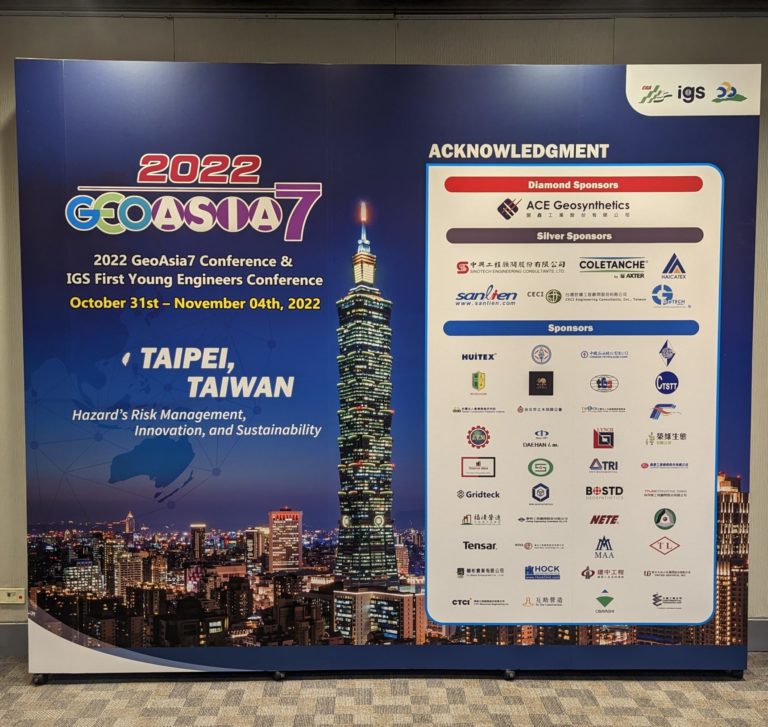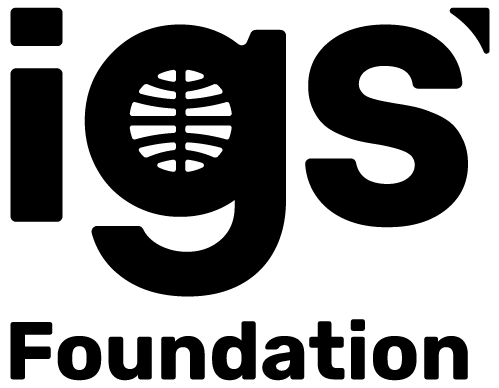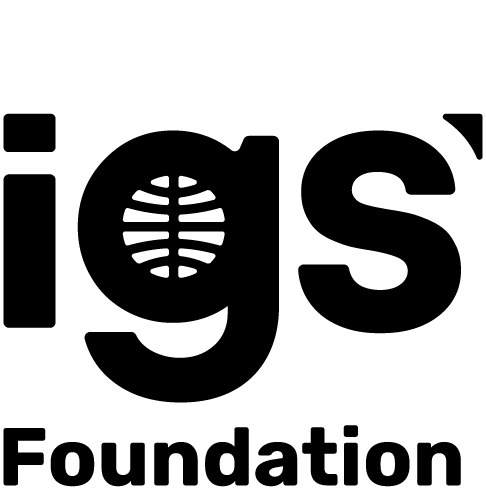 Two students attended the Young Engineers Conference at the 7th Asian Regional Conference on Geosynthetics thanks to a grant from the IGS Foundation (IGSF).
Two students attended the Young Engineers Conference at the 7th Asian Regional Conference on Geosynthetics thanks to a grant from the IGS Foundation (IGSF).
Hafsa Farooq, from the University of Technology in Sydney, Australia, and Meilani Adriyati, of Kyushu University in Fukuoka, Japan, were awarded scholarships for the event, which took place on the first day of the hybrid GeoAsia7 conference in Taipei, Taiwan, on October 31-November 4.
The funded places enabled them to meet peers – either virtually or in-person – from around the world, discuss their research projects and widen their knowledge, including learning from prestigious speakers including Professors Soon Hoe Chew, Junichi Koseki, Kerry Rowe, Fumio Tatsuoka and Abdelmalek Bouazza.
Both students said they appreciated the opportunity, which has made a significant impact on their ongoing studies.
Hafsa said: “I learnt about the vastness of my research area and the different experiments and technologies that are taking place worldwide, which will be helpful for my future endeavors.
“The conference was very interactive and the experiments and numerical investigations discussed by various presenters were valuable. In the future, I would wish to take part by presenting physically and involving myself more with face-to-face introductions and interactions with the famous and successful researchers.”
The conference speakers also made an impression on Meilani.
She said: “I met spectacular keynote speakers and invited lecturers in the geosynthetics world. The most special thing for me was meeting Dr. JP Giroud online because he is a pioneer of geosynthetics since 1970.
 “I learned that geosynthetics have proven to be a sustainable solution in various civil engineering projects and are increasingly used as regular construction materials in transportation. Therefore, geosynthetics’ success is due mainly to high performance, easy construction, and a lot of sustainable benefits. The future development of geosynthetics technology, especially in transportation applications, will need to be safe, easily applied, economically friendly and sustainable.”
“I learned that geosynthetics have proven to be a sustainable solution in various civil engineering projects and are increasingly used as regular construction materials in transportation. Therefore, geosynthetics’ success is due mainly to high performance, easy construction, and a lot of sustainable benefits. The future development of geosynthetics technology, especially in transportation applications, will need to be safe, easily applied, economically friendly and sustainable.”
Established in 2019, the IGSF aims to support and extend the education efforts of the IGS. It has already built up nearly $100,000 in donations and provided grants and scholarships that have enabled free conference attendance, and supported research projects and educational initiatives.
IGSF Treasurer Boyd Ramsey said: “It’s imperative we offer young engineers the opportunities to learn at the cutting edge of industry developments, and access networks to advance their research. We’re delighted to again have once again provided the means to do this at GeoAsia7. The IGSF is keen to support other initiatives in this way so please get in touch.”
You can read more about the IGSF in its latest annual report. You can also visit its website where you can learn how to donate or apply for a grant.
 Greece Geosynthetics Education Training Program — Educate the Educators ReportNovember 14, 2024 - 9:08 pm
Greece Geosynthetics Education Training Program — Educate the Educators ReportNovember 14, 2024 - 9:08 pm Diversity Spotlight At Next EuroGeo ConferenceOctober 25, 2024 - 10:48 pm
Diversity Spotlight At Next EuroGeo ConferenceOctober 25, 2024 - 10:48 pm Educate the Educators Event held in GreeceOctober 20, 2024 - 12:09 am
Educate the Educators Event held in GreeceOctober 20, 2024 - 12:09 am

Greece Geosynthetics Education Training Program — Educate the Educators Report
/by theigsfoundatiMost recently another Educate the Educators event was held in Xanthi, Greece 17–18 October 2024, again with Foundation support. We wish to express our deepest appreciation and gratitude to IGS, IGS Foundation and the instructors; with your help and support EtE was made possible. Click the link to download the report of IGS Greece, concerning the training program — 2024-11-14-EtE-IGSGreece-Report.
Diversity Spotlight At Next EuroGeo Conference
/by theigsfoundatiThe IGSF has supported the IGS diversity initiative since its creation. The Foundation funded a speaker on this topic at GeoAmericas and will continue this effort at the upcoming EuroGeo event. A link to a EuroGeo Diversity Lecture article is here: https://www.geosyntheticssociety.org/diversity-spotlight-at-next-eurogeo-conference/
Educate the Educators Event held in Greece
/by theigsfoundatiMost recently another Educate the Educators event was held in Greece, again with Foundation support. A formal report is forthcoming, LinkedIn postings are available here: LinkedIn links – Greece Educate the Educators: Escobar (https://www.linkedin.com/posts/maria-patricia-guerra-escobar-28b0217b_igs-ete-greece-just-wrapped-up-an-incredible-activity-7253731419246444545-Vbl8/) and Zornberg (https://www.linkedin.com/posts/jorge-zornberg-57932111_educate-the-educators-geosynthetics-education-activity-7256529017208545280-FaGL/).
11th The National Geosynthetics Conference
/by theigsfoundatiUpcoming events include participation and support for a major geosynthetics event in China – the 11th The National Geosynthetics Conference, a link is here: https://www.geosyntheticssociety.org/chinas-national-geosynthetics-conference-to-host-igs-special-session-on-reinforcement/
IGS Brazil expands the IGS Young Members Job Shadowing program
/by theigsfoundatiThe Brazil chapter has expanded the IGS Young Members Job Shadowing program. This allows young engineers, just entering the workplace to experience a day of site activity and learn what working in the geosynthetics field might be like. A link to the Brazil Young Members Job Shadowing program is here – https://igsbrasil.org.br/noticias/programa-job-shadowing-da-igs-foi-realizado-no-brasil-pela-primeira-vez/
IGSF Represented at GeoANZ2
/by theigsfoundatiThe Foundation was represented at GeoANZ #2 by our Board Chairman Jacques Cote. He presented at the conference gala. Also the Foundation funded student scholarships to allow young engineering students, who otherwise could not attend, to participate in the event. A link to the event website is here: https://geoanzconference.com.au/
Foundation Board of Trustees Participate at International Symposium Geosynthetics and Sustainability
/by theigsfoundatiThe Foundation Board of Trustees also participated in a Symposium presented by the IGS Netherlands chapter on sustainability involving geosynthetics. This coordinated with a Board meeting held adjacent to the symposium. A link to the Netherlands Sustainability Symposium is here: https://ngo.nl/symposium24/
Educate the Educators event held in Brisbane
/by theigsfoundatiPrior to the GeoANZ event the Foundation funded attendees at an Educate the Educators event held in Brisbane (https://www.acigs.org/events/2024-educate-educators ). Foundation support allowed professors, principally non-Australian, to travel to Brisbane and learn how to include geosynthetics in their universities engineering curriculum.
Educate the Educators on Geosynthetics, Brazil
/by theigsfoundatiBrazil’s sixth ETE program took place between November 17 and 19 in a hotel in São Paulo for 3 days of immersion in the world of geosynthetics. It was a very fruitful exchange and exceeded the expectations of both students and instructors, especially Prof. Maria das Graças Gardoni, coordinator of the project.
Key facts:
IGSF Sponsors Places At Young Engineers Conference
/by theigsfoundatiHafsa Farooq, from the University of Technology in Sydney, Australia, and Meilani Adriyati, of Kyushu University in Fukuoka, Japan, were awarded scholarships for the event, which took place on the first day of the hybrid GeoAsia7 conference in Taipei, Taiwan, on October 31-November 4.
The funded places enabled them to meet peers – either virtually or in-person – from around the world, discuss their research projects and widen their knowledge, including learning from prestigious speakers including Professors Soon Hoe Chew, Junichi Koseki, Kerry Rowe, Fumio Tatsuoka and Abdelmalek Bouazza.
Both students said they appreciated the opportunity, which has made a significant impact on their ongoing studies.
Hafsa said: “I learnt about the vastness of my research area and the different experiments and technologies that are taking place worldwide, which will be helpful for my future endeavors.
“The conference was very interactive and the experiments and numerical investigations discussed by various presenters were valuable. In the future, I would wish to take part by presenting physically and involving myself more with face-to-face introductions and interactions with the famous and successful researchers.”
The conference speakers also made an impression on Meilani.
She said: “I met spectacular keynote speakers and invited lecturers in the geosynthetics world. The most special thing for me was meeting Dr. JP Giroud online because he is a pioneer of geosynthetics since 1970.
Established in 2019, the IGSF aims to support and extend the education efforts of the IGS. It has already built up nearly $100,000 in donations and provided grants and scholarships that have enabled free conference attendance, and supported research projects and educational initiatives.
IGSF Treasurer Boyd Ramsey said: “It’s imperative we offer young engineers the opportunities to learn at the cutting edge of industry developments, and access networks to advance their research. We’re delighted to again have once again provided the means to do this at GeoAsia7. The IGSF is keen to support other initiatives in this way so please get in touch.”
You can read more about the IGSF in its latest annual report. You can also visit its website where you can learn how to donate or apply for a grant.